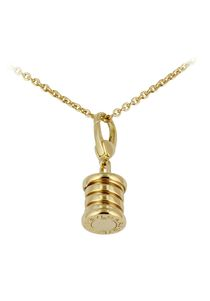Clear all filters
Bulgari Jewellery collection
Découvrez nos 4 jewellery bulgari. Tous les meilleurs modèles au meilleur prix, à acheter ou à rechercher.
All our Bulgari jewel
BULGARI
4 items
Bulgari, a House of jewelry with ties to Rome
The House of Bulgari is inseparable from Rome, the eternal city from which it has always drawn its inspiration. The story, however, does not quite begin in the Italian capital. No page would have been written if Sotorios Voùlgaris, a goldsmith by trade, had not left his Greek village of Paramythià at the age of 30 to try his hand at adventure, from Corfu, Naples and then finally, from store to store, Rome. His name Italianized to "Bulgari" - or "Bvlgari" - the traveling goldsmith founded the company in 1884, and quickly became known for his forged silver ornaments, which were highly prized by Anglo-Saxon tourists. It wasn't actually until 1910 that Sotorios Bulgari, aided by his two sons Giorgio and Costantino, launched into jewelry and fine jewelry. The influence of the French school, with Art Deco motifs, the use of platinum and diamonds, is felt in the first pieces of high jewelry. It would actually take another twenty years, as the sons took over from the father, for Bulgari to truly create an Italian style, between the brilliance of yellow gold and the undulations of Serpenti, which remains one of the House's signatures to this day.
Rome, the eternal inspiration of Bulgari
The eternal city has always inspired the Bulgari: Sotorios, his sons, his grandsons (who took over the House in the early 1980s, have transcribed in the jewelry collections the architectural treasures and chromatic symphonies of Rome, even in the House logo, which inevitably recalls the classical Latin alphabet. Thus the Monete line, born in 1966 and still relevant today, which redesigns the ancient coins of the Roman Empire. The curves and colors of the Diva's Dream collection echo the fan shape of the Baths of Caracalla, when B.zero1, launched in 1999, reinterprets the circular geometry of the Colosseum. When Bulgari introduced precious stones into its creations, not without audacity, in the mid-1950s, the House's artisans cut them in the shape of cobblestones to recall the cobblestone roadways built by the Romans. The cabochon also became a symbol of the House, like an allegory of the city's domes.
Jewelry favored by movie stars
To this inspiration, Bulgari added from the middle of the 20th century the audacity - sometimes the extravagance - of an avant-garde style, developing the image of a House ahead of its time and daring, between juxtaposition of materials and passion for color. Bulgari innovates, invents, declines over and over again its floral motifs and its serpenti, the snake symbol of wisdom, rebirth and vitality. Its scales are made into watch straps - and bracelets altogether - first in gold mesh, then with the flexible Tubogas rings. Above all, Bulgari seduces, and not just anyone, since it is the film stars who will build the brand's international reputation. As soon as the Second World War ended and the Cinecitta film studios opened in Rome, the Via Condotti boutique saw the likes of Gina Lollobridgida, Ingrid Bergmann, Audrey Hepburn, Romy Schneider and other Sophia Loren parade by. This is the Dolce Vita, the Bulgari jewelry appear in more than forty films, walk the red carpet of the Oscars, Cannes and Venice festivals. Elizabeth Taylor in particular, forges a special relationship with Bulgari. The owner of many unique and majestic pieces, she will undoubtedly be one of its best ambassadors. And the love between Bulgari and the stars of the seventh art or music does not seem ready to die out. Even today, the high jewelry collections are regularly worn by such famous faces as Charlize Theron, Lady Gaga or Alicia Keys.
Internationally renowned, infinite creativity
The fame acquired by Bulgari in the 1970s allows the brand to expand internationally. The House set up shop in Paris, Geneva and New York. Of the boutique and showroom in the Big Apple, Andy Warhol said: "I often go there because it is, in my eyes, the greatest museum of contemporary art in the world. The following decades were still the scene of Bulgari's creativity. Design is at the heart of the collections, inspirations diversify with the third generation of the family, the Orient and Pop Art inspire creations more surprising than the others. Bulgari addresses modern women, invents modular jewelry, versatile jewelry that can be worn from morning to night. The overflowing imagination of its creators also pushes the Italian House to dress its jewelry and watches with previously untapped materials, porcelain, silk, wood. Bulgari saw even further ahead, launching its Swiss subsidiary in 1980 in the production of watches, with its own calibers and pieces, and lines such as Bulgari-Bulgari, Serpenti or Astrale that further strengthened the brand's reputation. In Rome, the 1990s also sounded the hour of diversification to make Bulgari, and under the leadership of Francesco Trapani an Italian luxury giant: the first perfumes of 1993 succeeded silk scarves, accessories, eyewear and even ... hotels. In the early 2010s, Bulgari joined the LVMH group. The House then has 180 points of sale in the world, but the international deployment continues to the current 300 stores.










